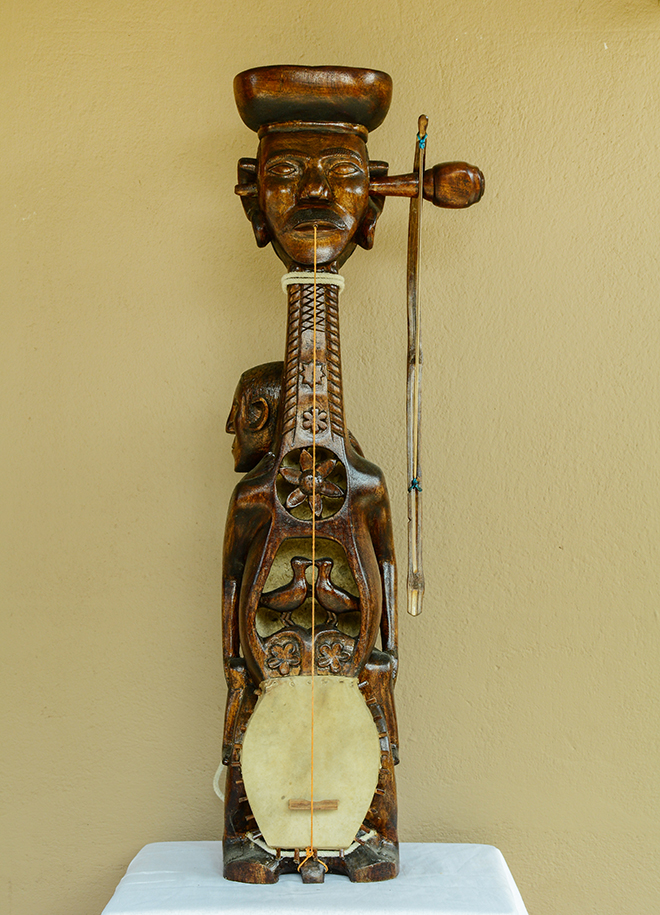
The majority are found in the Indian states of Bihar, West Bengal, Jharkhand, and Orissa, but a substantial number of Santals also live in Assam, in Nepal, and in Bangladesh. One may find Santals as migrant workers all over eastern South Asia.
The language of the Santals, Santali, belongs to the North Mundari group of languages, part of the Austroasiatic language family. The original home of the Santals is believed to have been the Champa Kingdom of northern Cambodia; their traditions indicate migration into India by way of Assam and Bengal.
Santals typically live in separate villages numbering from 400 to 1000 inhabitants each. Until recently, mud houses were preferred; houses are often decorated with floral designs. Houses normally have verandas and at least two rooms, of which the ‘inner room’ (chitar) contains the ancestors and the granary protected by them.
The Santals were originally hunters and gatherers. As a group, they have a broad knowledge of plants and animals. They also have an advanced hunting technology in the form of a wide variety of traps. Over time, their economic base shifted to slash-and-burn agriculture and husbandry; today they grow wet rice in terraced fields. On the plains, irrigation by canals and ditches is used. The Santals are generally non-vegetarian, and keep cattle, goats, and poultry. Fishing is important whenever they have access to rivers and ponds.
Traditionally Santals were experts in woodwork and woodcarving, and produced finely carved carts, utensils, and musical instruments, mainly for their own use. Basketwork, weaving of mats, and making of dishes and cups from sal leaves are crafts of some commercial importance. Santals sell their products for cash or barter at tribal markets; they also trade with Hindu villages.
Kinship and social life
The Santals are divided into 12 clans and 164 subclans. They are patrilineal and strictly endogamous. The clans are ranked according to old functional divisions: The Kisku were kings, the Murmu priests etc. In spite of this clan ranking, Santals are basically egalitarian, thus contrasting with their Hindu surroundings. On the village level, the local descent group is of major organizational importance.

Santals practice different forms of marriage, reflecting the relative positions of the spouses. The ideal form is bride-price marriage normally leading to the couple living with the man’s family, but where grooms have fewer resources, bride-service marriages leading to residence with the woman’s family do take place. In line with this flexibility in marriage practices one also finds divorce by mutual agreement, men marrying second wives, remarriage of widows, and special arrangements for finding grooms for unmarried mothers.
Household units tend toward extended rather than nuclear families. It is, however, common for sons to separate before the death of the father. Inheritance rules are complex, but land is usually divided among brothers, with smaller portions going to daughters as dowry. Grandparents of both sexes are important for the socialization of children; through them children normally receive their cultural education.
Recurring sources of conflict among Santals are sexual offences, jealousy, land disputes, money matters, and witchcraft. Witchcraft accusations are common. Many disputes are settled by compensation, usually decided by tribal assemblies, which function parallel to the Indian courts. Among the most serious offenses is breach of tribal endogamy, which is the responsibility of the local kin group and is normally punished with strict excommunication.
Religion and expressive culture
The Santal pantheon includes about 150 spirit deities, generally called bongas. Each village has a sacred grove, where benevolent bongas are found. The forest bongas, on the other hand, are malevolent, and include the souls of people who died an unnatural death. Santals assume that souls become bongas three generations after death if they perform the correct rituals. The dead body goes through a long process of death rituals where some bones are collected after cremation by the main mourner (usually the eldest son), and are washed and ritually fed with milk, rice beer, and sacred water by female mourners. Later the bones are immersed in water and a series of rituals is performed, releasing the dead from identity to become a nameless ancestor.
The village priest – naeke – and his wife are identified as representatives of the original Santal couple. Their function is mainly related to festivals and ceremonies. The priest consecrates the animals offered to the sacred grove deities. The ojha is a healer and diviner. He drives away the malevolent deities, divines the causes of disease, expels pain from the body, and administers medical remedies. Traditional medicine is highly developed and implies a large range of botanical and zoological knowledge. The making of remedies implies a considerable practical knowledge of chemistry.
Life-cycle rituals like initiation, marriage, and burial are celebrated individually. Most collective rites are related to the agricultural cycle or to hunting and gathering traditions. The most important among them is the flower festival, which is also the festival of ancestors.
Santal oral tradition is rich and includes folktales, myths, riddles, and village stories. Much of this material has in recent times been recorded or written down. Traditional songs are many and varied; each song accompanied by a particular type of traditional dance.
Source: Encyclopedia of world cultures, New York, N.Y.: G.K. Hall & Co. 1991

Resources:
- Daricha Foundation: The Santals
- Dr. Boro Baski: A brief introduction of Santal life and culture and our approach to development
- Daricha Foundation: Video documentation of Santal culture
- Adivaani: Banam Raja
- Marine Carrin: Inner frontiers; Santal responses to acculturation
- Hans Hadders: The Gift of the Eye. Mortuary ritual performed by the Jadopatias in the Santal villages of Bengal and Bihar, India
- Hans Hadders: Moving Identities: The Jatopatia, the Santals and the Myth of Creation